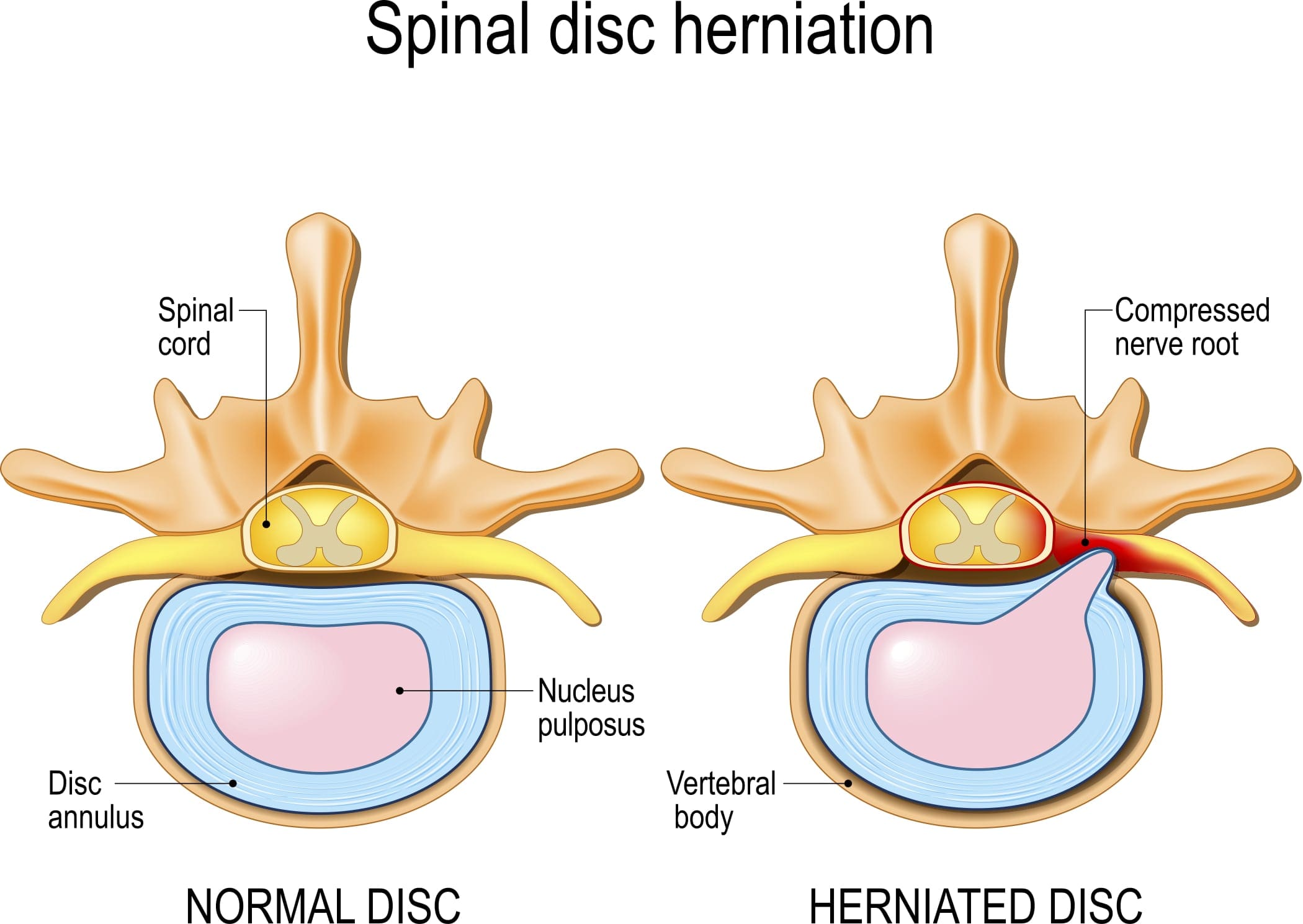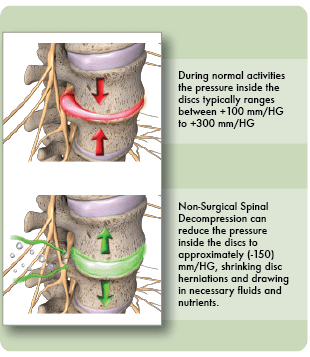Table of Contents
Introduction
The spine is encompassed by soft tissues, the spinal cord, ligaments, and cartilage in an S-shaped curvature in the back. The spine’s primary function is to make sure that the body is supported in an upright position and holds parts of the musculoskeletal system while also making sure that the body bends, sits, moves, twists, and turns for proper functionality. When the body goes through an injury, the symptoms can range from mild to severe depending on how bad the damage is on the person and how severe it is. When a back injury causes immense pain to the individual, the pain can radiate from the back to the legs. However, there are ways to lower the effects of back pain through non-surgical treatments like spinal decompression to help alleviate back pain symptoms. In this article, we will be looking at what lumbar disc herniation is, its symptoms, and how spinal decompression can help lower the effects of lumbar disc herniation. By referring patients to qualified and skilled providers specializing in spinal decompression therapy. To that end, and when appropriate, we advise our patients to refer to our associated medical providers based on their examination. We find that education is the key to asking valuable questions to our providers. Dr. Alex Jimenez DC provides this information as an educational service only. Disclaimer
Can my insurance cover it? Yes, it may. If you are uncertain, here is the link to all the insurance providers we cover. If you have any questions, please call Dr. Jimenez at 915-850-0900.
What Is Lumbar Disc Herniation?
In the back, the spine is in an S-shaped curve protected by soft tissue, the spinal disc, and the spinal cord. The spine makes sure that the body is moving and staying upright, and when there are factors that can cause back pain, it can lead to chronic issues that can affect the entire body. One of the chronic issues that can cause back pain is lumbar disc herniation. Research studies have found that lumbar disc herniation is due to aging and general wear and tear that causes the spinal disc to lose some of the fluid that makes them pliable and sponge-like.
Lumbar disc herniation is when the spinal disc’s outer ring can bulge, crack or tear when pressure is on the spine. This will cause the disc to protrude and push against a nearby spinal nerve root, causing shooting pain to the buttock and the leg. Research studies have shown that lumbar disc herniation is most often the result of disc degeneration. It is often due to individuals using their back muscles instead of their leg muscles to lift heavy objects. This can cause the spinal disc to twist and turn while lifting the heavy object and thus leading to a painful experience on the lower back.
The Symptoms
Research studies have found that nearly 80% of the population will usually sustain low back pain at least once. Since low back pain can be due to different factors, intervertebral degeneration leads to DDD (degenerative disc disease), and lumbar disc herniation as common sources. When the spinal disc starts to protrude from the spinal nerve, it can cause lumbar disc herniation to cause symptoms on the spine and the body. Some of the symptoms include:
- Inflammatory signaling
- The presence & effects of Propionibacterium acnes
- Microstructural changes to the nerve root
- Radicular pain
- Sensory abnormalities
- Pain from sitting, walking, sneezing
What Is Herniated Disc?-Video
Research studies have found that a herniated disc is a spinal injury. The spinal disc’s outer layer is weakened and cracked from the compressed pressure that the spine sustained from an injury, and the inner layer pushes through the crack to bulge out. Herniated discs from the spine are one of the leading causes of sciatica and can happen anywhere on the neck or the lower back. There are therapeutic treatments that individuals can utilize once the pain of herniated disc has gone away. Some of the treatments include:
- Resting for 1-3 days
- Applied heat or ice to the affected area
- Light stretching
- Physical therapy
- Spinal decompression
How Spinal Decompression Effect Disc Herniation
Research studies have stated that spinal decompression therapy and general traction therapy can provide effective results in improving the pain and disability of individuals suffering from intervertebral disc herniation. Since mostly about 80% of individuals have experienced lumbar pain, utilizing spinal decompression can help alleviate the effects of disc herniation. Other research studies have found that spinal decompression therapy can effectively help resorption the herniation and increase the disc height for individuals with lumbar disc herniation.
As part of a treatment for lumbar disc herniation, spinal decompression therapy can withdraw the inflammation from the sciatic nerve and reduce lumbar lordosis. The gentle traction on the spine from the traction table can reduce the pressure from the inside, thus shrinking the disc herniation and drawing in the necessary fluids, nutrients, and oxygen back to the spinal disc.
Conclusion
It is crucial to utilize spinal decompression therapy to treat lower back pain, herniated discs, and other common back problems. The spine makes sure that the body moves, twists, and turns. When a person pulls a muscle or injures their back from an accident or lifting something heavy will cause the spinal disc to bulge out and cause back problems to arise. Utilizing treatments for back pain like spinal decompression can help many individuals get the relief they deserve from the gentle spinal stretching to get the necessary nutrients back to the spine and alleviate the pressure pushing on the spinal disc.
References
Amin, Raj M, et al. “Lumbar Disc Herniation.” Current Reviews in Musculoskeletal Medicine, Springer US, Dec. 2017, www.ncbi.nlm.nih.gov/pmc/articles/PMC5685963/.
Choi, Jioun, et al. “Influences of Spinal Decompression Therapy and General Traction Therapy on the Pain, Disability, and Straight Leg Raising of Patients with Intervertebral Disc Herniation.” Journal of Physical Therapy Science, The Society of Physical Therapy Science, Feb. 2015, www.ncbi.nlm.nih.gov/pmc/articles/PMC4339166.
Demirel, Aynur, et al. “Regression of Lumbar Disc Herniation by Physiotherapy. Does Non-Surgical Spinal Decompression Therapy Make a Difference? Double-Blind Randomized Controlled Trial.” Journal of Back and Musculoskeletal Rehabilitation, U.S. National Library of Medicine, 22 Sept. 2017, pubmed.ncbi.nlm.nih.gov/28505956/.
Härtl, Roger. “Lumbar Herniated Disc: What You Should Know.” Spine, Spine-Health, 6 July 2016, www.spine-health.com/conditions/herniated-disc/lumbar-herniated-disc.
Medical Professionals, Cleveland Clinic. “Herniated Disk: What It Is, Diagnosis, Treatment & Outlook.” Cleveland Clinic, 1 July 2021, my.clevelandclinic.org/health/diseases/12768-herniated-disk.
Staff, Mayo Clinic. “Herniated Disk.” Mayo Clinic, Mayo Foundation for Medical Education and Research, 8 Feb. 2022, www.mayoclinic.org/diseases-conditions/herniated-disk/symptoms-causes/syc-20354095.
Disclaimer
Post Disclaimer
Professional Scope of Practice *
The information herein on "The Effects Of Spinal Decompression For Lumbar Disc Herniation" is not intended to replace a one-on-one relationship with a qualified health care professional or licensed physician and is not medical advice. We encourage you to make healthcare decisions based on your research and partnership with a qualified healthcare professional.
Blog Information & Scope Discussions
Welcome to El Paso's Wellness blog, where Dr. Alex Jimenez, DC, FNP-C, a board-certified Family Practice Nurse Practitioner (FNP-C) and Chiropractor (DC), presents insights on how our team is dedicated to holistic healing and personalized care. Our practice aligns with evidence-based treatment protocols inspired by integrative medicine principles, similar to those found on dralexjimenez.com, focusing on restoring health naturally for patients of all ages.
Our areas of chiropractic practice include Wellness & Nutrition, Chronic Pain, Personal Injury, Auto Accident Care, Work Injuries, Back Injury, Low Back Pain, Neck Pain, Migraine Headaches, Sports Injuries, Severe Sciatica, Scoliosis, Complex Herniated Discs, Fibromyalgia, Chronic Pain, Complex Injuries, Stress Management, Functional Medicine Treatments, and in-scope care protocols.
Our information scope is limited to chiropractic, musculoskeletal, physical medicine, wellness, contributing etiological viscerosomatic disturbances within clinical presentations, associated somato-visceral reflex clinical dynamics, subluxation complexes, sensitive health issues, and functional medicine articles, topics, and discussions.
We provide and present clinical collaboration with specialists from various disciplines. Each specialist is governed by their professional scope of practice and their jurisdiction of licensure. We use functional health & wellness protocols to treat and support care for the injuries or disorders of the musculoskeletal system.
Our videos, posts, topics, subjects, and insights cover clinical matters, issues, and topics that relate to and directly or indirectly support our clinical scope of practice.*
Our office has reasonably attempted to provide supportive citations and has identified the relevant research studies or studies supporting our posts. We provide copies of supporting research studies available to regulatory boards and the public upon request.
We understand that we cover matters that require an additional explanation of how they may assist in a particular care plan or treatment protocol; therefore, to discuss the subject matter above further, please feel free to ask Dr. Alex Jimenez, DC, APRN, FNP-BC, or contact us at 915-850-0900.
We are here to help you and your family.
Blessings
Dr. Alex Jimenez DC, MSACP, APRN, FNP-BC*, CCST, IFMCP, CFMP, ATN
email: coach@elpasofunctionalmedicine.com
Licensed as a Doctor of Chiropractic (DC) in Texas & New Mexico*
Texas DC License # TX5807
New Mexico DC License # NM-DC2182
Licensed as a Registered Nurse (RN*) in Texas & Multistate
Texas RN License # 1191402
ANCC FNP-BC: Board Certified Nurse Practitioner*
Compact Status: Multi-State License: Authorized to Practice in 40 States*
Graduate with Honors: ICHS: MSN-FNP (Family Nurse Practitioner Program)
Degree Granted. Master's in Family Practice MSN Diploma (Cum Laude)
Dr. Alex Jimenez, DC, APRN, FNP-BC*, CFMP, IFMCP, ATN, CCST
My Digital Business Card




